What is photography? – it is not just a picture
What is photography? It has often been described as the pencil of nature and its direct translation means drawing with light. It is a practise that enables us to capture what we see around us in a durable way.
Digital photography records light electronically onto a sensor, whilst older photography methods chemically capture images onto a light sensitive medium.
BUT It is much more than that
It is:
- a way of seeing
- a vehicle for speaking
- a way of making sense of the world
- a way connecting to our past
- a method of documenting the human story
- a window on other cultures
- a way of remembering loved ones
- it has been and still is used as a powerful propaganda tool
- it is a way of documenting time
- a way of illustrating
- a tool for exploration
A way of seeing
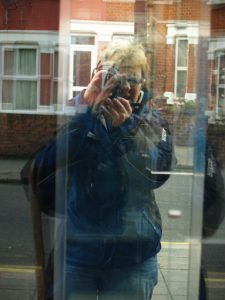
Nicola – What is photography
Put two people with cameras in front of a model or a scenic landscape and you will never get the same image. Each person will bring their own ideas, experiences and emphasis into play to create a totally personal comment.
A way of speaking
By using photographic techniques a photographer can highlight or draw attention to something they feel strongly about. They can comment on topics that they feel are wrong or that need to change.
See my series of blog posts called Better Photography 101. The different topics show how you can use camera techniques to direct the viewer of your photo to look at certain things. My blog post on cropping photos shows you how by cropping an image you can change the impact it has.
Social commentary
In the years during and after World War 2 magazines such as Picture Post and Life, published photos which commented on and highlighted marginalised areas of society.
They showed
- the conditions endured by immigrant populations
- inner city deprivation
- living conditions of the working class in the East End of London
- It also high lighted the disparity between the rich and the poor
- publishing contrasting images of areas of life such as education.
It was through the influence of publications such as Picture Post that institutions such as the National Health Service came into being.
A way of making sense of the world
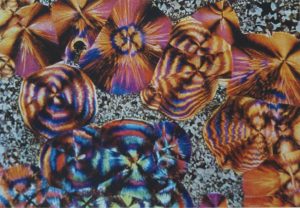
A macro autochrome
Even in the early days of photography, it has been a tool to enable to investigate the world around us.
- Coloured autochrome macro photography(1907) existed and allowed us to explore minute organisms in all their coloured beauty.
- Xrays, CT scans and MRIs allow us to examine areas inside our bodies
- powerful telescopes allow us to explore the farthest reaches of the Universe.
Early days
When photography was first invented, it could only capture images in black and white, allowing us to explore relationships between light and dark, tone and contrast. In 1907 the Lumiere brothers introduce the Autochrome (the first commercially viable colour photographic technique). Photographic representation became more ‘real’. The technique produced beautiful, rich colour images, with red being produced particularly well.
Remembering loved ones and connecting to our past
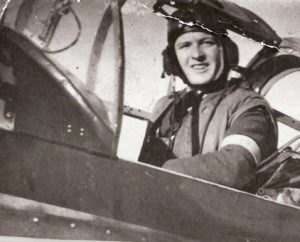
Uncle Jim in his Magister trainer
I’m sure most of us have boxes and albums of family members from the past and favourite photos from our own past. Being a photographer and photographer’s daughter, I have boxes and boxes of them. Small black and white shots, tiny ones from the war, slightly out of focus ones as the person. Images where someone’s head has been cut off slightly, you know the ones.
Do we edit them? Throw them out? Delete them because they’re not photographically and artistically perfect? No, we keep them because they are us, all that we as a species and a person are.
They are our history, our story
Photos help ground us in time. They give our lives value and meaning. A way of connecting us to our past. An archive of all that has been before.
Why did the Victorians photograph their dead children?
Many Victorians would photograph their dead children. This may seem rather macabre to us today. Exposure times were very long and children weren’t always able to stand still for that long. Youth and child mortality was very high. Commissioning a photograph of their dead child, was therefore a way for the parents to capture that all elusive portrait.
A window on other cultures
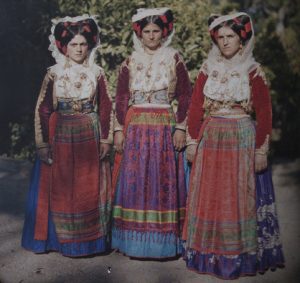
Balkan ladies in their national dress, showcasing how the Autochrome process enhanced the reds of their outfits – What is photography?
Albert Khan was a wealthy philanthropist who lived in France at the time of the emergence of the Autochrome. He believed he could help create world peace and understanding through photography. He bankrolled and undertook a world photographic expedition he called the Archive of the Planet (The Life of Albert Kahn The Wonderful World of Albert Khan).
Kahn and his chauffeur travelled the world, photographing countries as diverse as China, Ireland, Japan, the Western Front in WW1, Africa, Middle East, Asia and Scandinavia. They also photographed notables such as George Bernard Shaw.
The collection of images he produced cover events of historic proportions including
- the death and funeral of the Japanese Emperor at the time
- conditions, troops and weapons in the trenches of WW1
- rural villages in Ireland
- other historic happenings.
Looking through the images, it is hard to believe that they are over 100 years old. They bring the past to life and connect us more deeply with our past and the past of other cultures.
A powerful propaganda tool
A picture is worth a thousand words
During WW2 images were used by both sides to promote their ideals. Picture Post magazine often carried pictures and articles that promoted members of the services. Picture Post photographed women who worked in the munitions factories, helping to improve morale.
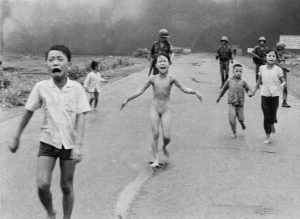
FILE – In this June 8, 1972, file photo, 9-year-old Kim Phuc, center, runs with her brothers and cousins, followed by South Vietnamese forces, down Route 1 near Trang Bang after a South Vietnamese plane accidentally dropped its flaming napalm on its own troops and civilians. The terrified girl had ripped off her burning clothes while fleeing. In late September 2015, Phuc, 52, began a series of laser treatments at the Miami Dermatology and Laser Institute to smooth and soften the pale, thick scar tissue that she has endured for more than 40 years. (AP Photo/Nick Ut, File)
During the Vietnam War, photographers showed the ravages of war, helping to give voice to the Peace movement.
A way of perpetuating hoaxes – The camera never lies….. or does it?
The Cottingley Fairies
The most famous photographic hoax is that of the Cottingley Fairies. Two cousins Elsie Wright and Frances Griffiths who lived in Cottingley near Bradford, produced a series of five photographs which claimed to show fairies dancing in a glen. Many people at the time, including Arthur Conan Doyle, believed the photos to be genuine. For most of their lives the girls continued to claim that the images were real. In the early 1980s the girls came clean, saying that they had created the fairies with cardboard cut outs from a children’s book of the time. Frances however continued to claim that the fifth image was genuine. What do you think?
The Moon landings
Another images that have caused great interest and controversy are those of the moon landings. Most people believe that we did put men on the moon and take photos. Others point out possible evidence that claims to show these images may have been created in a studio. What do you think?
Nude versus naked
Photography has been used in artistic ways to explore the nude and create beautiful erotic images, but with lots of new techniques it is also used by the p o rn industry. When does nude, artistic and tasteful, become naked, p o rnographic and obscene? I’ll leave you to decide that one 🙂
The Selfie

Selfie in Mexico
The latest photographic fad is The Selfie. From the highest to the lowest in the world, we are all self promoting through the wonders of the Smart Phone.
This is a selfie I took in Mexico during one of their tropical storms.
So – What is photography?
I’ve only skimmed the surface of what photography is, in this article. Hopefully I’ve encouraged you to think more about this very powerful tool.

It is true that a picture paints a thousand words and your blog clearly captures the wide variety that those words can take. For me photography is about enabling me to be visually creative when I am not an artist. I am a writer so usually paint my pictures with words: photography allows me to express my creative nature in a medium what would otherwise be closed to me.
Interesting view point Nicci. Having grown up with photography, I had never thought about the more conceptual side of what photography was. I learned a lot on my photography course and put links in to 2 of the books we used on the course.